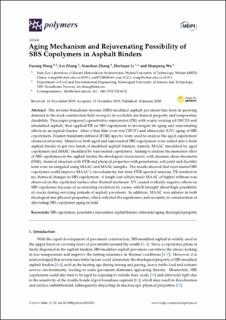| dc.description.abstract | The styrene–butadiene–styrene (SBS)-modified asphalt pavement has been in growing demand in the road construction field owing to its workable mechanical property and temperature durability. This paper prepared a penetrative rejuvenator (PR) with waste cooking oil (WCO) and emulsified asphalt, then applied PR on SBS copolymers to investigate its aging and rejuvenating effects in an asphalt binder. After a thin film oven test (TFOT) and ultraviolet (UV) aging of SBS copolymers, Fourier transform infrared (FTIR) spectra were used to analyse the aged copolymers’ chemical structure. Moreover, both aged and rejuvenated SBS copolymers were added into a fresh asphalt binder to get two kinds of modified asphalt binders, namely, MAAC (modified by aged copolymer) and MARC (modified by rejuvenated copolymer). Aiming to analyse the monomer effect of SBS copolymers in the asphalt binder, the rheological characteristic with dynamic shear rheometer (DSR), chemical structure with FTIR and physical properties with penetration, soft point and ductility tests were investigated using MAAC and MAAC samples. The results showed that rejuvenated SBS copolymer could improve MAAC’s viscoelasticity, but from FTIR spectral analysis, PR resulted in no chemical changes to SBS copolymers. A tough coat which made MAAC of higher stiffness was observed on the copolymer surface after thermal treatment. UV caused evidently negative effects on SBS copolymer because of accelerating oxidation by ozone, which brought about high possibility of cracks during servicing periods of asphalt pavement. In addition, MAAC was inferior in both rheological and physical properties, which reflected the significance and necessity in consideration of alleviating SBS copolymer aging in field. | en_US |

